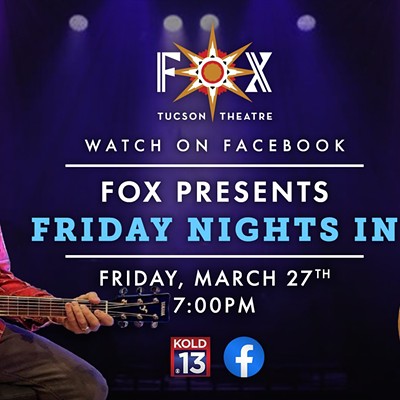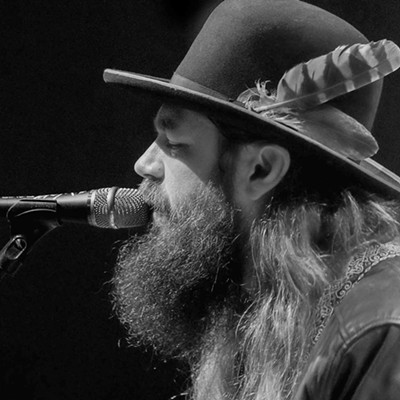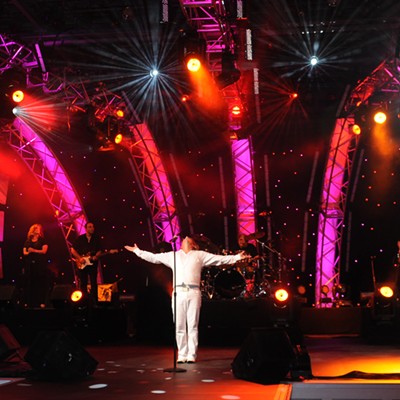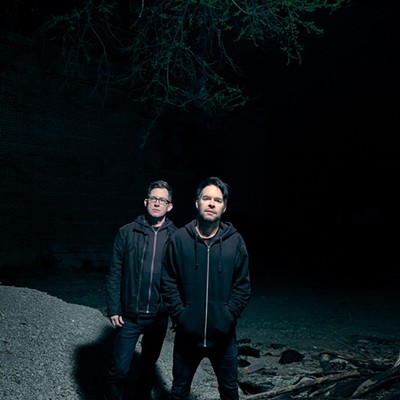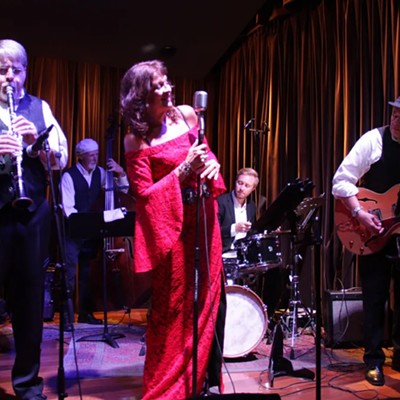"That alternate world happened between 1935 and 1945," says "Ranger Doug, idol of American youth" and cowboy guitarist for the band, Riders In The Sky. In his alter ego as author Douglas B. Green, he has written the definitive history of the genre, Singing In The Saddle: The History of the Singing Cowboys, published by Vanderbilt University Press.
Riders In The Sky, which will perform March 26 with the Western swing trio Hot Club of Cowtown, also features Fred "Too Slim" LaBour on bass, "Woody Paul" Chrisman--a former nuclear physicist--on fiddle and Joey "The CowPolka King" Miskulin on accordion.
According to Ranger Doug, singing cowboys Gene Autry, Roy Rogers and others represented a counterpoint to the helplessness of the Great Depression of the 1930s. They were a vision of America's westward expansion as seen through Los Angeles and New York. They attained huge popularity, with every major studio except MGM churning out Westerns featuring cowboys with guitars and sidekicks.
"There was a big jazz influence," Ranger Doug notes. "The music of Stephane Grappelli and Django Reinhardt was coming across the ocean at the same time that the cowboys got to the movies and that had a huge effect on the sound.
"Some of the results were sublime, some were dreadful," he adds. "People rightly make fun of some of the schlocky stuff. But the music of Billie Hill, Bob Nolan and Tim Spencer was music for the ages. Lyrically, it was very expansive. It was about the West. It was not about broken hearts, feeling sorry for yourself, or the Depression. That mixed with the folk influence and then the professional songwriters in New York got into it. Songs like "Along the Navaho Trail" and "Don't Fence Me In" were just glorious."
By 1940, Gene Autry was the fourth-most-popular star in movies, alongside icons like Clark Gable and Humphrey Bogart. But changing times and World War II shifted national attention to broader concerns.
"Then the public moved on," he admits. "Part of it was the inevitable cycle of entertainment. Part of it was the war. After the horrors of real war, that beautiful, sunny fantasy of a guy who could solve problems with a song and shoot a six-gun out of the villain's hand without harming him in any way wasn't a fantasy we could maintain. Detectives went into noir; Westerns went into the adult Westerns. The whole Depression era fantasy of which cowboys were a part went away."
Riders In The Sky formed in 1977 to play a gig at a sandwich shop, dressing in glitzy cowboy costumes and creating cowboy personas. They built their stage patter around the ethos of "the Cowboy way," based on the squeaky-clean singing cowboy image, where doing the right thing and following the rules were more important than convenience.
"People read a lot of different things into it," Ranger Doug explains. "Nobody really took the movies seriously, yet you feel that they were telling you something very true about America. We've never been on a moral crusade, but it doesn't hurt for people to be reminded that there are other ways of doing things besides the 'gangsta' way."
Since the sandwich shop gig, they've racked up more than 4,500 performances, became members of the Grand Ole Opry, had their own TV series on the Nashville Network, built a public radio franchise, "Riders Radio," and became a fixture of the American music scene.
"We've been around so long, it's spooky," concedes Ranger Doug.
Today, children are a significant audience for the band. Both of their Grammys are in the Best Children's Album category, for Woody's Roundup Featuring Riders In the Sky, based on their inclusion in the Toy Story II soundtrack, and last year for Monsters Inc. Scream Factory Favorites.
"I loved Gene and Roy and Hopalong Cassidy and the Lone Ranger," Ranger Doug says. "It amazes me now to see kids looking up at us with those admiring looks, because that's exactly what I felt."
In contrast to the camp nostalgia of Riders In The Sky, one of the best Western swing revival outfits, Hot Club of Cowtown, is part of a new generation of past-sensitive, forward-thinking musicians. The Cowtown trio plays neo-retro, contemporary nostalgia or whatever you want to call it. The category includes artists as diverse as Gillian Welch, Nickel Creek and Squirrel Nut Zippers. All pay homage to a traditional sound, but with an updated style that is genuinely contemporary.
Cowtown fiddler and vocalist Elana Fremerman notes that, "Even though our influences are from that era, we try to avoid trapping ourselves in the past. We don't want people thinking we're encrusted in retro, when in fact, all music is derived from something before it. Even though we love that style of playing and have an extreme fascination and respect for those singers and players, that doesn't mean we're not doing things our own way in 2003."
The Cowtown trio also includes guitarist Whit Smith and bassist Jake Erwin.
"With a trio, the energy just goes into a vortex," Fremerman explains. "There's something about the 'pitched-forward' nature of our music that the audience can relate to. We all play flat out rather than cool."
Bolstering the traditional style of Bob Wills, the trio cites the jazz guitar/violin combination of Eddie Lang and Joe Venuti, Louis Armstrong, Bix Biederbecke and Reinhardt and Grappelli's Hot Club of France. Rather than simply look back, however, they aim to synthesize a new sound.
"Obviously our songs are influenced by that style, but the subjects and sentiments are stuff that we've come up with ourselves, so it's also modern," Fremerman explains. "There's nothing old or tired about it. There's also nothing ironic or tongue-in-cheeky kind of thing in the way we play."
Fremerman notes the original hot jazz element that came from France in the 1930s is really All-American.
"A lot of people think that Hot Club of France was the first time that a violin was used in a jazzy way," she says, "but Joe Venuti and Eddie Lang were doing that before them. Django Reinhardt and Stephane Grappelli heard that and added a lot of the gypsy element, so when it came back, it sounded different."
Riders In The Sky and Hot Club of Cowtown play a number of dates together and have a mutual admiration.
"I love those young people," says Ranger Doug of his friends in Hot Club of Cowtown. "They're great. We do an extended jam of Western swing at the end of the show. One of the ways we stay fresh is to play a lot of jazz. To be able to play with them is joy. They're so charismatic on stage."

